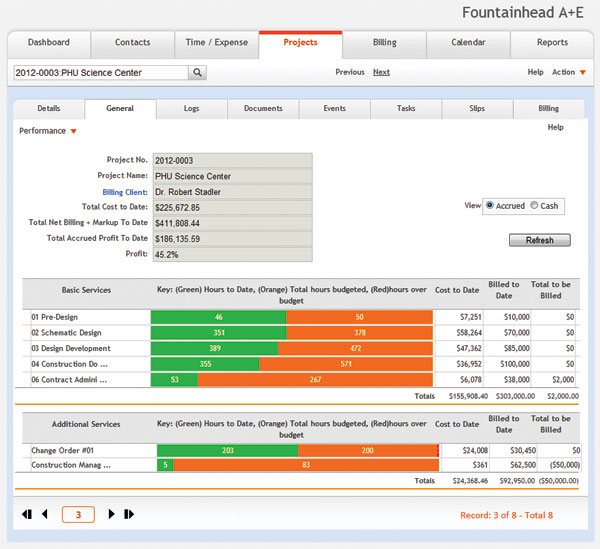Effective Financial Management of Architectural Firms
Using Financial Systems to Keep Firms Profitable
Once you have trustworthy cash projections, the firm can be more nimble and adaptable to changing financial and economic conditions, Wintner writes, because cash-flow tools “can help a firm plan ahead to smooth out the swings in cash flow by accelerating collections, requesting an initial payment prior to starting a project, and carefully planning purchases of equipment and supplies.” Wintner also cautions that some firms may see a “habitual dependence on a line of credit,” which usually indicates structural problems with the firm's financial situation.
As the cash flow budgeting process shows, there is a certain minimum level of complexity to managing any professional service firm's finances, even if it's a three-person architecture-and-interiors practice. Drawing up a monthly cash-flow report takes time and access to all the required data. A 12-month projection takes a bit of math, but many firms use automated systems and software that can churn out the answers immediately—if the data entered is reliable.
“The cash-flow example opens the door to a discussion of the practical aspects of financial management,” says BQE Software's Burns. “These are the day-to-day things that really need to happen in any architectural firm, no matter how small.” Key management competencies required for all firms—and the associated software and hardware for automating these efforts—include:
▶ Accounting. “This may be obvious, but all firms need some form of accounting software,” says Burns, noting that a number of effective and inexpensive accounting products are on the market. “Choose an accounting software that is both highly affordable and scalable.” If possible, the base financial accounting software should be backwards-compatible with any other accounting systems that have been used in the firm.
When used properly, the accounting products serve as an effective tool to help principals understand their own businesses. It also provides a single platform for managing the company's basic accounting needs, such as taking care of the bills owed (accounts payable), and to efficiently run common financial reports, such as the balance sheet and income statement.
▶ Payroll. The accounting software product is also used to handle payroll. However, once the architecture firm reaches a certain size—typically 4-5 people employed, or more—many firms choose to migrate to an outside payroll system vendor. There are many of these companies on the market, and even the largest international vendors work with very small businesses.
The fees charged by payroll service providers vary, so the firm should do some initial research before selecting the best payroll company for the firm. Note that they can do a lot more for the firm than just payroll, such as preparing reports. They are also responsible for making sure payroll taxes and benefit contributions are paid on time, so the firm is never penalized for late payments. “It takes the burden away from you, the firm owner, so you can focus on what you do best,” says Burns.
▶ Project management. One of the reasons why leading architecture firms use software to manage building projects is, when properly used, the projects and people will be organized and efficient. PM software manages people and time over the course of specified project-related activities. Being able to track these variables will make sure the firms are making the most productive use of its direct hours—in other words, the hours employees and partners spend on projects, as opposed to hours spent on overhead activities.

Image courtesy of BQE Software
Software is used to manage building project progress and billing in an organized and efficient manner, tracking people and time over the course of specified project-related activities.
By integrating financial accounting software with project management software, architecture firms can maintain a clear picture of their progress on building work as well as their use of firm resources. Taken together, this can be called enterprise resource planning, or ERP, which describes the management competency while it also implies the use of firm-wide system software.
According to market researcher Noel Radley with the company Software Advice, “The size of the firm will have a big impact on the software needs. For example, a larger firm, dealing with multiple projects and employees, will need more robust project and time-tracking capabilities than an individual freelancer.” Radley recommends the following questions be asked when a firm is evaluating architectural accounting software:
▶ Can the system log hours and mark as billable or non-billable?
▶ How deep are the project scheduling/progress tracking capabilities?
▶ Can the system effectively manage costs and progress for multiple projects at once?
▶ Does the software come with solid report-writing mechanisms?
Once armed with these answers, says Radley, the firm leadership can consider how and when to make the investment.









